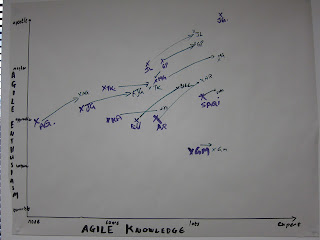Caveats:
None. Being capable of bringing life to notes by drawing, infographic creating or just simple graphically facilitation of ideas and information for self or groups is extremely valuable! Only, balance time drawing with time facilitating or engaging with the group members to ensure there is growth of the shared knowledge space. Some group members may find watching someone drawing for too long distracting. (this is feedback from a paired training session where my colleague was training whilst 1 was in the background capturing and marking up what he was saying)
I can't draw well. As someone said - with writing, or speaking, we're given a lot of feedback, and even though we may be poor writers or speakers we have to do it. Not so with drawing. We are born with the ability to make marks on things. Because of poor feedback at early age typically, those without strong urge or ability, usually make a conscious decision somewhere to not draw anymore.
But these days, where nearly everything is group/team work, the ability to draw "good enough" is becoming a really key and useful ability to have.
And then I found Bikablo - or rather a colleague of mine told me about it. And then suddenly I could (and still can) draw some the patterns I find most useful for the work that I do.
Required:
The Bikablo book: http://www.neuland.com/DE/facilitation-tools-jc4rdwszaiw/bikablo-6s5uy80465f.html (in German/English) which is also sometimes available from amazon here
A set of thin+thick coloured markers as per Bikablo recommendation - I prefer the Artline ones which are usable on whiteboards as well as being comfortable on flipchart paper!
Some/lots of time to practice beforehand!
Step 1: Practice, and then practice some more. Pick just a handful of useful basic shapes and 2-3 colour pair combinations that you like
Step 2: Slowly bring them into your sessions and grow confidence that you can draw, and you can draw well enough so that people actually praise your work/talent!
Step 3: Within a couple of sessions over the time of a few weeks or months, you'll be drawing extremely high quality session outputs that people will be asking to keep for themselves. Success!
Step 4: Always take photos of all your facilitated graphics and be sure to get them back to the group as soon as possible after the session! Done well, you will not need to type them up! Win!!
None. Being capable of bringing life to notes by drawing, infographic creating or just simple graphically facilitation of ideas and information for self or groups is extremely valuable! Only, balance time drawing with time facilitating or engaging with the group members to ensure there is growth of the shared knowledge space. Some group members may find watching someone drawing for too long distracting. (this is feedback from a paired training session where my colleague was training whilst 1 was in the background capturing and marking up what he was saying)
I can't draw well. As someone said - with writing, or speaking, we're given a lot of feedback, and even though we may be poor writers or speakers we have to do it. Not so with drawing. We are born with the ability to make marks on things. Because of poor feedback at early age typically, those without strong urge or ability, usually make a conscious decision somewhere to not draw anymore.
But these days, where nearly everything is group/team work, the ability to draw "good enough" is becoming a really key and useful ability to have.
And then I found Bikablo - or rather a colleague of mine told me about it. And then suddenly I could (and still can) draw some the patterns I find most useful for the work that I do.
Required:
The Bikablo book: http://www.neuland.com/DE/facilitation-tools-jc4rdwszaiw/bikablo-6s5uy80465f.html (in German/English) which is also sometimes available from amazon here
A set of thin+thick coloured markers as per Bikablo recommendation - I prefer the Artline ones which are usable on whiteboards as well as being comfortable on flipchart paper!
Some/lots of time to practice beforehand!
Step 1: Practice, and then practice some more. Pick just a handful of useful basic shapes and 2-3 colour pair combinations that you like
Step 2: Slowly bring them into your sessions and grow confidence that you can draw, and you can draw well enough so that people actually praise your work/talent!
Step 3: Within a couple of sessions over the time of a few weeks or months, you'll be drawing extremely high quality session outputs that people will be asking to keep for themselves. Success!
Step 4: Always take photos of all your facilitated graphics and be sure to get them back to the group as soon as possible after the session! Done well, you will not need to type them up! Win!!



